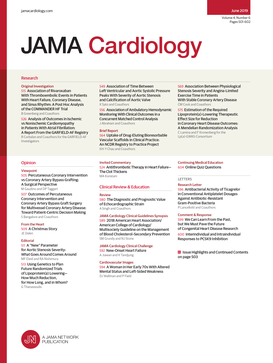基于急诊科的高血压教育和移动健康赋权干预
IF 14.1
1区 医学
Q1 CARDIAC & CARDIOVASCULAR SYSTEMS
引用次数: 0
摘要
高血压是心血管疾病的主要危险因素,但常常未被诊断出来。急诊科(ED)访问是医疗保健的关键接入点,为高血压筛查和干预提供了独特的机会。目的评价教育和移动健康授权(E2)干预与常规护理相比在降低ED出院血压升高患者的收缩压(SBP)方面的有效性。设计、环境和参与者本随机临床试验招募了因任何适应症到城市学术医疗中心ED就诊且血压升高(≥140/90 mm Hg和≤180/110 mm Hg)的参与者。在2019年2月12日至2023年3月31日期间,从急诊科出院的符合条件的参与者被纳入研究,并被随机分配接受常规治疗或干预,并在3个月和6个月时进行随访。干预:通常的护理包括标准的高血压出院指导和门诊随访转诊。E2干预涉及三管齐下的方法,包括与临床药剂师或高级执业护士进行简短的急性高血压护理后咨询(PACHT-c),支持智能手机的血压监测工具包(Withings设备和移动应用程序),用于日常自我监测以及行为改变短信,以及初级保健转诊。主要结局和测量主要结局是收缩压(mm Hg)从基线到6个月的平均变化。结果入组的574名参与者,平均(SD)年龄为51.1岁(12.5岁),其中323名(56%)为女性;413人是黑人(72%),115人是西班牙裔或拉丁裔(20%),27人是白人(5%),19人是其他种族和民族(3%),其中包括亚洲人、美洲印第安人和其他种族或民族。在6个月时有血压数据的413例患者中,E2干预组(n = 210)的收缩压平均降低幅度更大(平均差值为4.9 mm Hg;95% CI, 0.8-9.0 mm Hg;P = 0.02),与常规护理组(n = 203)比较。干预组(42.9%[90 / 210])和对照组(36.9%[75 / 203])患者在6个月时血压小于或等于140/90 mm Hg的比例相似;P = .22)。结论和相关性在这项单中心随机临床试验中,针对血压升高的ED患者的多组分干预与6个月时收缩压的显著降低相关。识别到急诊科就诊的高血压患者可能是改善血压管理的可行策略。临床试验注册号:NCT03749499本文章由计算机程序翻译,如有差异,请以英文原文为准。
Emergency Department–Based Education and mHealth Empowerment Intervention for Hypertension
ImportanceHypertension is a leading risk factor for cardiovascular diseases and is often undiagnosed. Emergency department (ED) visits serve as critical access points within health care and present a unique opportunity for hypertension screening and intervention.ObjectiveTo evaluate the effectiveness of an Education and mHealth Empowerment (E2) intervention compared with usual care in reducing systolic blood pressure (SBP) among patients with elevated BP discharged from the ED.Design, Setting, and ParticipantsThis randomized clinical trial enrolled participants who presented to an urban academic medical center ED for any indication and had elevated blood pressure (≥140/90 mm Hg and ≤180/110 mm Hg). Eligible participants who were discharged from the ED were enrolled between February 12, 2019, and March 31, 2023, and were randomized to receive either usual care or the intervention with follow-up visits at 3 and 6 months.InterventionsUsual care involved standard hypertension discharge instructions with a referral for outpatient follow-up. The E2 intervention involved a 3-prong approach, which included a brief Post-Acute Care Hypertension consultation (PACHT-c) with a clinical pharmacist or an advanced practice nurse, a smartphone-enabled BP monitoring kit (Withings device and mobile app) for daily self-monitoring along with behavior change text messages, and primary care referral.Main Outcomes and MeasuresThe primary outcome was the mean change in SBP (mm Hg) from baseline to 6 months.ResultsOf the 574 participants enrolled, mean (SD) age was 51.1 (12.5) years, and 323 (56%) were female; 413 were Black (72%), 115 were Hispanic or Latino (20%), 27 were White (5%), and 19 were other race and ethnicity (3%), which included Asian, American Indian, and other racial or ethnic groups. Of the 413 patients with BP data at 6 months, the E2 intervention group (n = 210) showed a greater mean reduction in SBP (mean difference, 4.9 mm Hg; 95% CI, 0.8-9.0 mm Hg; P = .02) compared with the usual-care group (n = 203). A similar proportion of patients achieved BP less than or equal to 140/90 mm Hg at 6 months in the intervention arm (42.9% [90 of 210]) and the control arm (36.9% [75 of 203]; P = .22).Conclusions and RelevanceIn this single-center randomized clinical trial, a multicomponent intervention directed at patients in the ED who have elevated BP was associated with greater reduction in SBP at 6 months. Identifying patients who present to the ED with hypertension may be a viable strategy to improve BP management.Trial RegistrationClinicalTrials.gov Identifier: NCT03749499
求助全文
通过发布文献求助,成功后即可免费获取论文全文。
去求助
来源期刊

JAMA cardiology
Medicine-Cardiology and Cardiovascular Medicine
CiteScore
45.80
自引率
1.70%
发文量
264
期刊介绍:
JAMA Cardiology, an international peer-reviewed journal, serves as the premier publication for clinical investigators, clinicians, and trainees in cardiovascular medicine worldwide. As a member of the JAMA Network, it aligns with a consortium of peer-reviewed general medical and specialty publications.
Published online weekly, every Wednesday, and in 12 print/online issues annually, JAMA Cardiology attracts over 4.3 million annual article views and downloads. Research articles become freely accessible online 12 months post-publication without any author fees. Moreover, the online version is readily accessible to institutions in developing countries through the World Health Organization's HINARI program.
Positioned at the intersection of clinical investigation, actionable clinical science, and clinical practice, JAMA Cardiology prioritizes traditional and evolving cardiovascular medicine, alongside evidence-based health policy. It places particular emphasis on health equity, especially when grounded in original science, as a top editorial priority.
 求助内容:
求助内容: 应助结果提醒方式:
应助结果提醒方式:


